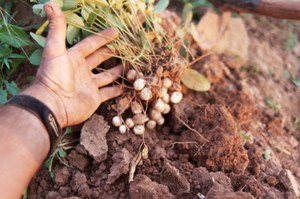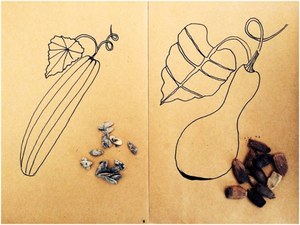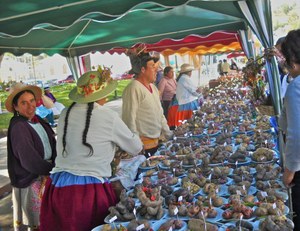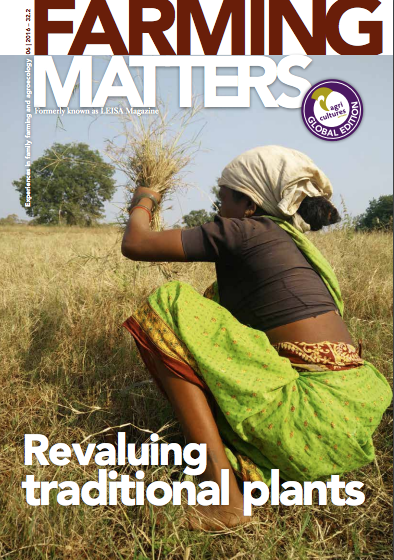Just as plants, humans will not survive without their roots. The experiences here highlight initiatives in which farmers, peasants,and educators have successfully organised themselves to rescue their traditional crops and revive their culinary traditions, thereby strengthening their cultural identity.
India
Crop diversity makes school kids proud

Chandan’s grandmother is surprised to find her 10 year old grandson carefully taking down the recipe of jhungre ki kheer, a pudding made with barnyard millet, that she has not tasted in the past 30 years. Chandan is one of the children from Odhla High School, Govindpur participating in a traditional recipe competition conducted in their school by the Smallholder Innovation for Resilience (SIFOR) team. The programme has been working in five villages in the Kumaon Himalayas since 2012 to assess aspects of traditional agriculture, its climate preparedness and to support a revival of traditional crops. The effects of climate change, amongst other factors, have played a major role in many farmers’ decisions to give up farming and opt for regular wages, often in urban areas. This has taken its toll on many traditional grains and pulses, with some having completely disappeared. But, the past four years have seen progress, with some traditional crops regaining popularity, on farmers’ fields and in the newly setup community seedbank. Measures to ensure the long term success of this biodiversity revival include the involvement of existing institutions such as schools, as well as creating new ones like women’s self help groups and crop-protection committees.
The recipe competition engages kids to not only learn about his agricultural heritage but also become a successful farmer who is proud of the diversity of crops on his farm.
Contact Prakriti Mukerjee (mukerjee.prakriti@gmail.com).
Zambia
Bambara groundnut gets the attention it deserve

Bambara groundnut (Vigna subterranea), a legume crop indigenous to sub-Saharan Africa, is widespread amongst smallholders in Zambia. Farmers adapt cultivation techniques depending on their soil and climate. For instance, in drier regions it is planted next to termite mounds and in wetter regions on top of ridges. However, it is often outcompeted by crops such as maize and cassava. This prompted farmers to start experimenting three years ago. Concern Worldwide, an international NGO, facilitated the farmers’ experiments which also included cowpeas, soybeans and peanuts. One result was the high density at which Bambara groundnut can be successfully planted and that it is great for intercropping due to its drought tolerance. Beatrice Sepiso, a farmer from Kaoma district explains: “We would have to cultivate one lima (0.25 hectares) of lituu (Bambara groundnuts) the old way to achieve what was managed in two lines!” Access to enough seed and reducing the labour required to process the groundnut are two remaining challenges. As well, the cultural, nutritional and agronomic value of such indigenous foods needs to be celebrated in the national discourse around food sovereignty. Contact Paul Wagstaff (Paul.Wagstaff@concern.net).
Palestine
Seeds of resistance

Climate change, urban expansion of the Israeli settlement, and the dominance of hybrid seeds are putting many farmers’ traditional varieties and Palestine’s farming heritage at risk. This prompted Vivien Sansour to return home to the West Bank city of Beit Jala to start the ‘Palestinian Heirloom Seed Library’. While there is a seed bank in Palestine, established by the Union of Agricultural Work Committees in 2008, the library, sponsored by the Walid and Helen Kattan Science and Education Program and A.M. Qattan Foundation, combines science education and art. In the lead up to the library’s launch in June this year, Sansour conducted workshops with school teachers to find new ways to engage students in the process of retrieving, “their agri-cultural heritage.” Sansour: “We want to bring back the true meaning of talib (student in Arabic) to the classroom. We want our young generations to question and search for what is rightly theirs, an ancient ancestral heritage represented in seed and story that has kept us alive and well for millennia.” Sansour hopes that by building cultural links to their past and reversing the disappearance of their traditional plants, young Palestinians will strengthen the resistance of the occupation. At the launch, in Battir, guests were able to view the seed collection, the work of the students and teachers, as well as heirloom plant varieties growing on one of Battir’s world heritage site terraces.
Contact Silvia Sarapura Escobar (ssarapur@alumni.uoguelph.ca)
Peru
A chef-peasant alliance

In 2007, the Peruvian Gastronomy Society started promoting alliances between small scale farmers and chefs to bridge biodiversity and the culinary use of traditional Peruvian foods. This initiative, coined ‘the Chef and Peasant Alliance’, seeks to support small producers, artisanal fishermen, and peasant producers to link with Peru’s gastronomic sector. The main objective was to take action against the loss of agrobiodiversity and social inequality. Through the alliance’s promotion of local produce, farmers avoid intermediaries and obtain better prices for their products through direct commercialisation at weekly markets and food fairs. Cooks, chefs, and restaurateurs, on the other hand, profit from this business opportunity as they depend on agricultural products and the enormous diversity of traditional crops, tubers, and fruits. The alliance, moreover, serves as a platform for knowledge sharing where chefs and peasants learn from each other’s realities, needs, and aspirations and innovate new dishes and ways of producing. In this process, farmers gain awareness of how valuable their products are to their fellow Peruvians: during food fairs, farmers and their products receive a lot of attention from the media, the public, research organisations and NGOs. The fairs are not only a means of empowerment for farmers, but also a celebration of Andean agrobiodiversity.
Contact Silvia Sarapura Escobar (ssarapur@alumni.uoguelph.ca)

